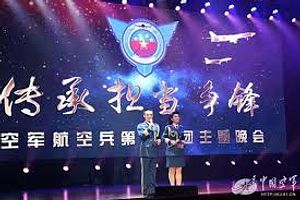China’s People’s Liberation Army Air Force (PLAAF) may unveil its recently designated Hong-20 (H-20) long-range strategic stealth bomber during a parade as part of the service’s 70th anniversary celebrations in 2019. The possible participation of the H-20 in the PLAAF anniversary parade was first reported by Defence Blog on October 15.
Speculations over a possible participation of a H-20 prototype was further fueled by the display of a new logo featuring the silhouette of a flying wing-style aircraft, thought to be the new H-20 aircraft, at a recent official gala of the strategic bomber division under the People’s Liberation Army (PLA) Eastern Theater Command.
The designation of the new bomber was first publicly revealed in August during a documentary broadcast by China Central Television in which the aircraft was referred to as the “Hong-20” a “new long-range strategic bomber” under development for the PLAAF. According to Defense News, the documentary added that “great progress” is being made on the H-20 development.
A maiden flight of the aircraft could occur in early 2020.
Details about the H-20’s design and capabilities remain limited. However, there is a broad belief that the new aircraft, developed by Xi’an Aircraft Industrial Corporation (XAC), will have a stealthy flying wing design with an internal weapons bay similar to the U.S. Air Force’s B-2 Spirit bomber.
The 603rd Aircraft Design Institute, a partner organization of XAC, has reportedly been working on new stealth bomber designs since the 1990s. According to some analysts, one of the major obstacles for a next-generation stealth bomber remains the design and development of an indigenous high-performance turbofan engine for the aircraft.
The Diplomat’s Rick Joe notes that construction of the first prototype of the H-20 may have begun in 2015 and may have rolled out already in 2017. Rick also summarized characteristics of the new bomber discussed in a Chinese language article on a PLA-affiliated website:
- Reaffirmation that H-20 would adopt a flying wing configuration with “good stealth performance”;
- An intercontinental range, with numbers stated of a combat radius over 5,000 kilometers;
- A lower payload than B-2, but a substantially larger payload than H-6K, which would correspond to a modern large aircraft powered by four non-afterburning WS-10s;
- Capable of carrying nuclear and conventional payloads.
Additional characteristics also suggest the PLAAF envisions the H-20 to be a more multirole aircraft than traditional bombers like the B-2, and is more reminiscent of roles the USAF has called for their B-21 Raider:
- “Almost as good as a special electronic combat aircraft in electronic combat capability”;
- The mounting of high powered radar, high powered microwave, and laser and infrared equipment to effect and destroy missiles and other air to ground targets;
- Large capacity data fusion and transmission, which aligns with the PLA’s overall understanding of informationized warfare;
Acting as a C4ISR node and “interacting” with a large number of platforms such as UAVs, AEW&C, and reconnaissance aircraft to share information and target data.
The PLAAF’s basic requirement for an aircraft to be designated a strategic bomber is a minimum range of 8,000 km (5,000 miles) without refueling and the capacity to carry a payload of more than 10 tons of air-to-ground munitions. It is estimated that the new bomber could enter service with the PLAAF as early as 2025. Notably, there has not been official confirmation from Chinese authorities yet over the possible unveiling of the new aircraft during the PLAAF anniversary parade in 2019.

































